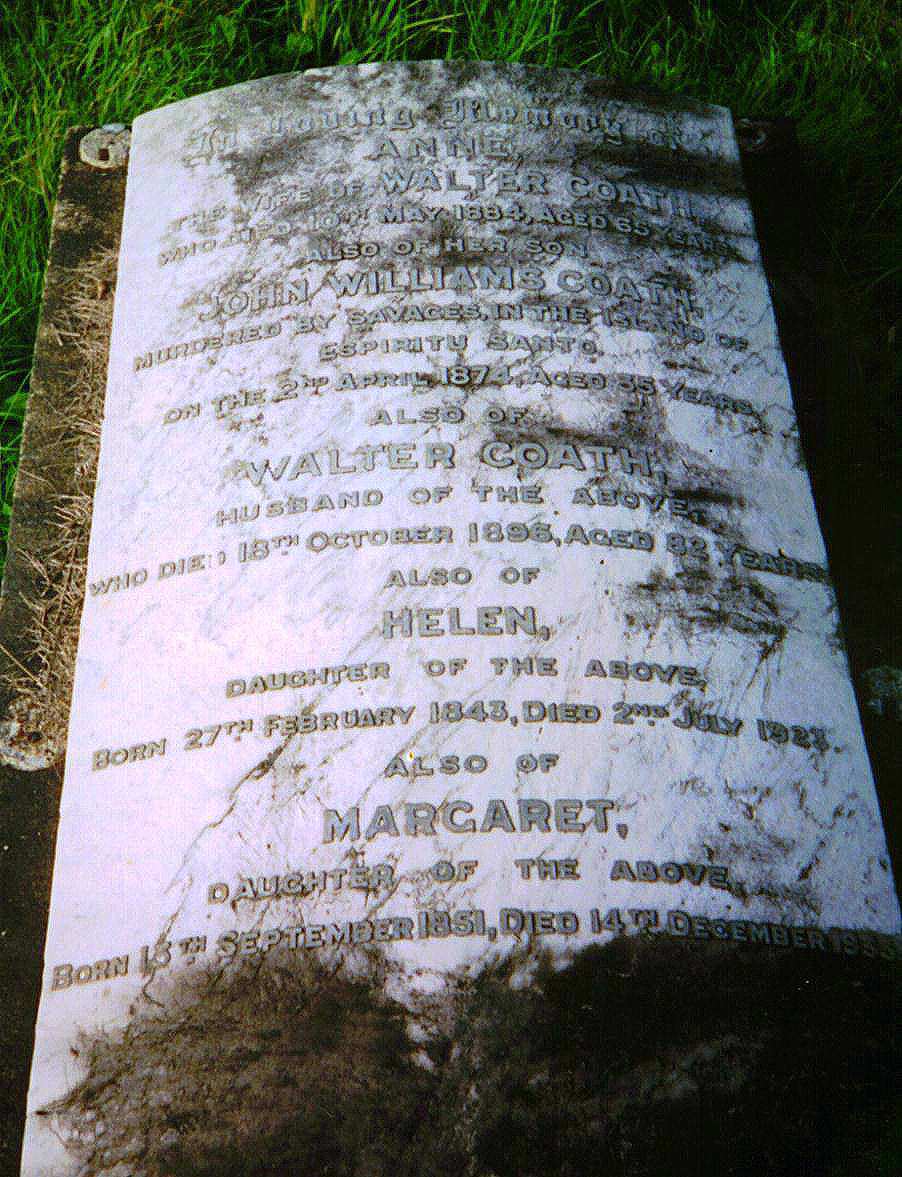Coath Photo's
Links to Societies
Links to Vendors

Anne
The wife of Walter Coath
Who died 10th May 1884 aged 64 years
Also of her son
John Williams Coath
Murdered by savages in the Island of
Espirito Santo
On the 2nd April 1874 aged 35 years
John Williams Coath was born in 1839 in Plymouth, Devon.
His parents were Walter Coath, a 26 year old Inland Revenue Inspector born in St Austell, Cornwall and Annie Gilston, born in Ireland. Walter was the son of Robert Coath, himself an Inland Revenue Officer and also the grandson of the hanged Francis Coath.
Due to his fathers work, the family spent a lot of time travelling around the West Country and Ireland where several of the family were born.
On September 7th 1858, John Williams Coath married MariaYeoman at St Mary's in Limehouse. Exactly nine months later she gave birth to a son whom they named Walter Yeoman.
For reasons unknown John Williams Coath then vanished from the scene as on March 12th 1862 Maria shows up as a widow at her wedding to Joseph Robert Bradbrook in Stepney.
Meanwhile on February 16th 1863, on the far side of the world in Newcastle, New South Wales, John Williams Coath was getting wed to Henrietta Kinamond.
Coath was serving as First Mate on the schooner Spunkie under Ross Lewin operating in the South Seas.. The Spunkie strongly resembled the missionary schooner Southern Cross which was also operating in the area.
The Spunkie would preceed the mission boat to the islands by several days.
The idea was that as soon as the ship dropped anchor, the crew would stand around with books singing hymns.
Coath, who had a smattering of the local language, would then dress in a white macintosh, white bell-topper, spectacles and umbrella, and be rowed ashore.
Once there he would hand out pages from some nautical almanac as if they were biblical tracts and explain that the Bishop was detained onboard but would like to invite all his friends to join him.
Once the natives boarded the ship they were clapped in irons to be sold to the sugar plantation owners.
Coath later became the Master of the schooner Jason. During one of his trips in 1871, he kidnapped a government agent and chained him in the hold for more than three weeks, by which time he had gone "Stark raving mad" and was therefore unable to give evidence.
Coath was finally caught by the authorities and after a lengthy trial he was found guilty of the third of four separate counts of offences against natives and sentenced to five years.
The trial of Coath was to have many legal repurcussions; The law on slavery related to the practise of kidnapping white English men, women and children and selling them to the plantations of Virginia and later those in Australia.
This had the effect of removing those Englishmen and women from the protection of the laws of England.
Coath's lawyers argued that by taking the Islanders, who did not currently enjoy that protection, and then delivering them to Australia he was in fact granting them the right of protection under the law.
He was pardoned in September 1873 but was to die the following year from spear wounds on the island of Espiritu Santo.